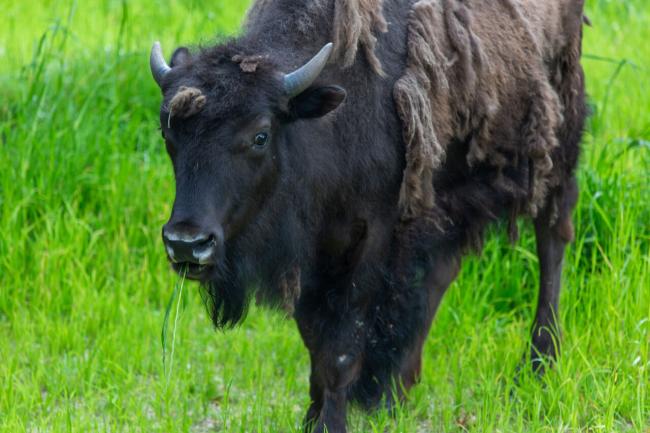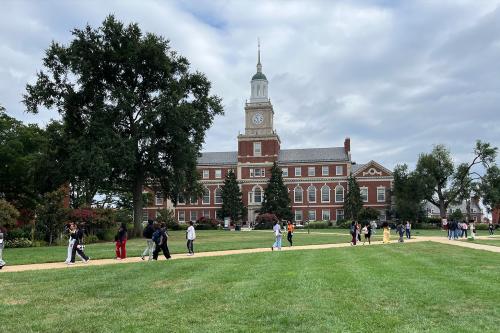WASHINGTON –The Smithsonian’s National Zoo and Conservation Biology Institute have welcomed “Lucy” and “Gally,” two juvenile female American bison. American bison were the first animals to begin the Zoo’s living collection in 1889, sparking the conservation movement.
“American Bison have a rich history with the Zoo since our founder William Temple Hornaday envisioned a national zoo where vanishing species would thrive, starting with the bison,” said Steve Monfort, John and Adrienne Mars Director of the Smithsonian’s National Zoo and Conservation Biology Institute. “Connecting the bison with the communities of Howard University and Gallaudet University gives us the opportunity to inspire a younger generation to appreciate this iconic American species and reminds us all that we can save wildlife and their habitats.”
Howard University and Gallaudet University have a special connection to the species, which serves as their mascots. The Zoo partnered with the same universities to name the last two bison as well. Students, faculty, staff and alumni from Gallaudet University selected the name Gally, which is the fond name of their mascot on campus and a nickname for Gallaudet.
“Gallaudet University is once again honored to be joining forces with Howard University and the Smithsonian’s National Zoo to welcome two new American bison to the Washington, D.C. area,” said Roberta J. Cordano, president of Gallaudet University. “Our mascot Gally has been an enduring and central figure enjoyed by many Gallaudet generations so it is only fitting that Gally will now be recognized as part of the Zoo’s living collection.”
Howard University students, faculty, staff and alumni chose to name one bison “Lucy,” in honor of Lucy Diggs Slowe. Slowe was the first dean of women at Howard University and the first African American woman to hold that position at an American university She was also a national tennis champion and the first Black woman to win a major sports title.
“We appreciate the Smithsonian’s National Zoo for extending this opportunity to name their new baby bison as a symbol of fellowship between our collective institutions,” said Dr.Wayne A.I. Frederick, president of Howard University. “Dean Lucy Diggs Slowe was a remarkable woman, and we’re happy that her legacy and memory will be shared with every visitor interested in learning about the strength of the mighty bison.”
Lucy and Gally are about a year old and weigh approximately 200 pounds each; at full maturity, female bison can weigh up to 1,100 pounds. When the Zoo reopens, visitors will see the bison trot, wallow, rest and graze in their outdoor habitat located on Olmsted Walk near the Bus Parking Lot entrance. Until then, fans can brush up on their bison facts on the Zoo’s website.
Lucy and Gally came to the Zoo from the American Prairie Reserve in northeastern Montana.
The Reserve spans more than 300,000 acres of public and private land. With an ecosystem that supports an abundance of wildlife, from mighty bison to tiny insects, the prairie is one of North America’s greatest treasures. But decades of alterations have drastically changed this landscape and affected the plants and animals that call it home. Smithsonian scientists are collaborating with the American Prairie Reserve to help understand, restore and preserve the iconic wild landscape.
The International Union for Conservation of Nature (IUCN) lists American bison as a species that is near threatened by extinction; IUCN does not consider commercial herds in designating population status. Bison have made a comeback since their populations were decimated to just 375 individuals, but the species still depends heavily on conservation action for survival. Today, about 30,000 individuals comprise the conservation herds. Approximately 500,000 are managed as livestock by private commercial ventures.
# # #
About Howard University
Founded in 1867, Howard University is a private, research university that is comprised of 13 schools and colleges. Students pursue studies in more than 120 areas leading to undergraduate, graduate and professional degrees. The University operates with a commitment to Excellence in Truth and Service and has produced one Schwarzman Scholar, three Marshall Scholars, four Rhodes Scholars, 11 Truman Scholars, 25 Pickering Fellows and more than 165 Fulbright recipients. Howard also produces more on-campus African-American Ph.D. recipients than any other university in the United States. For more information on Howard University, visit www.howard.edu.
Media Contact: Misha Cornelius, misha.cornelius@howard.edu





